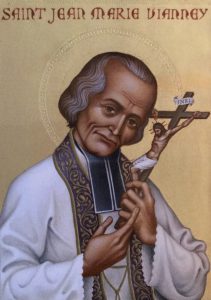We hear so often about how uncivil the public discourse has become. Everyone is talking past one another and no one seems to be listening. No one understands, or tries to understand, the other. Our collective manners leave much to be desired and grace seems to have taken a holiday. (This is not a political screed, I promise!)
Perhaps, then, it is a most apropos moment for a relic of the Catholic Church to be making a national tour of the United States. Though I was raised in the Catholic faith, I confess that I am ignorant about much of Church ritual, in particular the veneration of relics and their miracle healing. I had mostly understood the word relic (or relict) in the context of early cemeteries. From the Latin word reliquiae, relic means remains, or left behind. One sees the word frequently on old slate headstones, a beloved wife remembered as the relic, a widow at the time of her death. So when a headline came across my news feed that the St. John Vianney Relic Pilgrimage, sponsored by the Knights of Columbus, was coming to the Boston Archdiocese Pastoral Center in Braintree, Massachusetts, it caught my attention for a couple of reasons.
First, the Archdiocese has very much been in the NEHGS news thanks to a multi-year, historic collaboration to digitize and make parish records available online. At some point in my genealogical research I will get to my Boston Irish Catholic ancestors and will, no doubt, find myself reacquainting with the faith. Learning more about the St. John Vianney relic might, I thought, be a good first step.
I have to admit that I was also captivated by what seemed to be the rock star status surrounding this relic, with dates in cities and towns across the country and its own web page, updated as new dates were added. Everywhere the relic had visited, the media had covered the event. One headline shouted, “This will be so cool!” At many previous stops it had been standing room only and lines had extended out the doors of churches. The faithful had driven hours, across state lines, for a glimpse. It was not the sort of frenzied welcome that I expected of a holy church treasure. So, not knowing what it was all about, but with an open mind, I stood in line to see for myself the Heart of a Priest.
I have to admit that I was also captivated by what seemed to be the rock star status surrounding this relic, with dates in cities and towns across the country and its own web page...
On a small altar, in an ornate gold, seventeenth-century French reliquary, there was the actual heart – the incorrupt heart – of Jean Vianney, a nineteenth-century French priest, who was canonized in 1925. One by one visitors knelt in prayer, face to face – or more appropriately, heart to heart – with the relic. In the Catholic faith, relics are classified as First, Second, or Third Class, according to how directly they are associated with events in Christ’s life or with a saint. People across all faiths shared the relief of Catholics worldwide whose prayers were answered when the treasured Crown of Thorns, a First Class relic, believed to have been worn by Jesus at his crucifixion, was saved from the Notre Dame fire.
St. John Vianney’s heart – deserving of special veneration because the heart is considered the core of a person – is also a First Class relic, thus its star billing and the desire by so many of the faithful to reverently touch an object to the reliquary, thereby creating their own personal Third Class relic. As I observed those quiet acts of faith by ordinary people they didn’t seem all that different from the spiritual connection – and comfort – that we family historians derive from honoring the cherished physical objects associated with our ancestors.
As an historical figure, Saint John has an interesting story. One of six children, Jean Marie Vianney was born to poor but devout Catholic parents near Lyon, France in 1786. From early childhood he desired to be a priest though his preparation was interrupted by the dechristianization of France during the French Revolution and later by his own conscription into Napoleon’s army in 1809. Whether deliberately or accidentally, he was separated from his company and hid out with deserters in a rural village until a decree of amnesty for deserters was issued in 1810, after which he resumed his studies and entered the seminary.
Though he struggled with his learning, in particular Latin, he was ordained in 1815 and in 1818 was appointed priest of the tiny village of Ars, then a parish of 260 unruly folks who, during the turbulent years of war, had lost faith and drifted from the church. Not only did Father Vianney restore the faith of wayward villagers, he also built an orphanage and traveled regularly from Ars to minister to many in surrounding villages who had been left destitute in the aftermath of the Napoleonic wars.
Word of his holiness and healing powers spread widely, though Father Vianney, the Curé d’Ars, gave much of the credit for his miracles to the intercession of St. Philomena, an early Christian martyr who died at the age of thirteen. Devotion to her began to spread after her tomb was discovered in 1802 and miracles began to take place through her intercession. Jean Vianney accounted her his guardian and favorite saint.
By 1827, Ars had become a destination, welcoming tens of thousands of pilgrims each year seeking spiritual counsel. For up to eighteen hours each day, Father Vianney heard their confessions, connecting with each on a deep, personal level. In 1873, fourteen years after his death in 1859, he was proclaimed venerable and in 1905 he was beatified. On 31 May 1925 he was canonized, and in 1929 he was named the patron saint of parish priests. His feast day is 4 August, the day of his death.
By 1827, Ars had become a destination, welcoming tens of thousands of pilgrims each year seeking spiritual counsel.
Since November, when the Heart of a Priest tour kicked off in the United States, pilgrims have been flocking in the hundreds and thousands at each stop. The visit to Braintree, fresh off five previous stops in Massachusetts and with two additional stops in the Commonwealth before heading to New Jersey, was a quieter affair, thereby giving me the opportunity to talk for a while with several women from the Pastoral Center who told me they had been uplifted by the event.
Expecting a religious reply, something that embodied all the mystery of the faith, I asked them what St. John Vianney meant to them. “He was patient,” one of the women remarked. “He was a very good listener,” said the other. “He listened with his heart.”
Perhaps it really is as simple as that.
Share this:

About Amy Whorf McGuiggan
Amy Whorf McGuiggan recently published Finding Emma: My Search For the Family My Grandfather Never Knew; she is also the author of My Provincetown: Memories of a Cape Cod Childhood; Christmas in New England; and Take Me Out to the Ball Game: The Story of the Sensational Baseball Song. Past projects have included curating, researching, and writing the exhibition Forgotten Port: Provincetown’s Whaling Heritage (for the Pilgrim Monument and Provincetown Museum) and Albert Edel: Moments in Time, Pictures of Place (for the Provincetown Art Association and Museum).View all posts by Amy Whorf McGuiggan →
